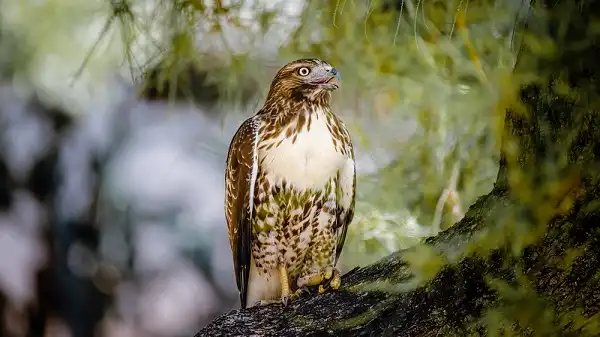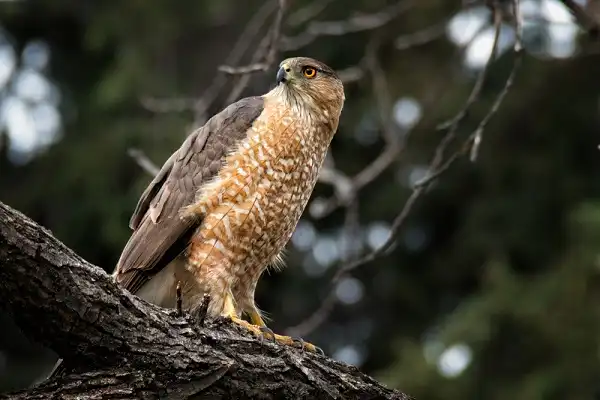Are you an avid birdwatcher, or just curious to learn more about these beautiful creatures? If so, you’ve come to the right place! The Cooper’s Hawk (Accipiter cooperii) is one of the most common and easily recognized members of North America’s hawk family. With its distinctive coloration and call, it can be found almost anywhere in the United States. This post will provide general information on Coopers’ Hawk identification and behavior as well as tips for attracting them to your backyard. Read on to find out why this unique creature is such a fascinating addition to any landscape – from city parks to rural fields!

Cooper’s Hawk Description
The Cooper’s Hawk (Accipiter cooperii) is a medium-sized bird of prey native to North America. It has a large, powerful body and wingspan with striking black and white barring on its back and tail feathers. Its call is distinctive and often carries for long distances, easily recognizable by experienced birders. With its adept flying skills, the Cooper’s Hawk can be seen snatching prey from trees or even chasing unsuspecting birds in midair. This hawk has dark brown or black feathers on its back and head, while its chest and abdomen are usually white or light gray with reddish-brown barring. Its tail is marked by several narrow bars that help it maneuver in flight. Its sharp eyesight allows it to swoop down suddenly upon small animals below the canopy making it an efficient hunter. Furthermore, its adaptability makes this hawk an easy tenant of both urban parks as well as more rural settings due to their ability to survive in various habitats without any difficulty. The Cooper’s Hawk can make a wonderful addition to your backyard; simply provide nesting material such as branches or sticks near dense shrubs or treetops that are close together!
Cooper’s Hawk Habitat
The Cooper’s Hawk is known to inhabit a wide range of habitats, from open woodlands to grasslands and even urban parks. They are most often found in deciduous forests, particularly those with dense tree cover. Additionally, they can be seen in coniferous forests, swamps, and riparian areas. When it comes to food availability, Coopers Hawks prefer areas that have plenty of small mammals such as mice or voles as well as birds for hunting. In urban areas, these hawks often take advantage of their surroundings by preying on pigeons and ducks. Cooper’s Hawks typically build their nests near the tops of tall trees with thick foliage for protection from predators. The nest itself can consist of twigs, bark strips, or other vegetation pieces which are often lined with softer materials like feathers or fur. These nests may be reused multiple times over up to 5 years.
Cooper’s Hawk Diet
The Cooper’s Hawk has an omnivorous diet that includes small animals such as rodents, birds, lizards, amphibians, and even insects. They are also known to feed on carrion or steal food from other predators. Birds are the primary prey of this hawk, with songbirds being the most commonly hunted species. To catch their prey, they often use tactics such as surprise attacks or stealthy pursuits. The Cooper’s Hawk also takes advantage of seasonal fruits and berries in the summer months when they are abundant. In many urban areas, these hawks often scavenge for scraps of discarded human food or pick leftover bits off plates or trays left behind by humans. This behavior allows them to remain successful predators without having to expend much energy searching for food.

Cooper’s Hawk Size
The Cooper’s Hawk is a medium-sized bird of prey that typically measures between 14 and 21 inches in length. It has a wingspan of around 24 to 41 inches, making it one of the larger members of its genus. The female tends to be about 25% larger than the male, with an average weight ranging from 7 ounces to 2 pounds. Cooper’s Hawks have sharp talons as well as powerful hooked beaks which they use to capture and kill their prey. They have an excellent vision that allows them to spot small animals from hundreds of feet away.
Cooper’s Hawk Lifespan
The average lifespan of a Cooper’s Hawk is approximately 5 to 7 years in the wild, however, some individuals may live up to 14 years old. The oldest recorded age for this species was a Hawk found in New Jersey that had lived to be 17 years old. In captivity, Coopers Hawks are known to live even longer with some reaching over 20 years of age. Coopers Hawks have several predators in their natural habitat including larger birds of prey such as Golden Eagles and Bald Eagles, as well as terrestrial predators like coyotes and foxes. They also face threats from humans through hunting and accidental death due to vehicle collisions or electrocution. To ensure the longevity of Cooper’s Hawks, conservation efforts have been put in place to protect their habitats and discourage any human-related activities that could be harmful to them. These efforts have proven successful in stabilizing their population numbers across North America, which has allowed these hawks to continue thriving in different ecosystems throughout the continent.
Cooper’s Hawk Behavior
Coopers Hawks are highly adapted to the environment in which they live. They possess excellent vision and can spot small animals from hundreds of feet away, allowing them to hunt with great success. They use their sharp talons and powerful hooked beaks to capture and kill their prey. During the hunting process, they rely heavily on their agility and airspeed. In addition to actively hunting their prey, Coopers Hawks also scavenge for scraps of discarded human food or pick leftover bits off plates or trays left behind by humans. This behavior allows them to supplement their diet year-round with necessary nutrients and calories that may not be found in some of their smaller victims, further ensuring their survival in different ecological systems across North America. The behaviors exhibited by Coopers Hawks make them successful predators that are well-equipped to deal with changes in available food sources. Through a combination of active hunting and resourcefulness, these hawks can ensure they stay well-fed regardless of what habitats they inhabit throughout the year.

Cooper’s Hawk Speed
Coopers Hawks have an impressive air speed of up to 40 miles per hour, making them one of the fastest-flying birds in North America. This is primarily attributed to their light body weight and long, narrow wings that allow them to maneuver quickly and efficiently through the air. In addition to their airspeed, they can flap their wings at a rate of up to 60 times per minute, allowing them to traverse large distances with relative ease.
Cooper’s Hawk Hunting
Coopers Hawks employ a variety of hunting techniques to capture their prey. They use a combination of keen vision, agility and speed to locate, chase and catch their targets. While most Coopers Hawks primarily hunt during daylight hours, they have been known to hunt occasionally at night as well. When pursuing small prey such as rodents or birds, Cooper’s Hawks utilize their incredible speed and agility to quickly close the gap between them and their target. They stomp through the underbrush with their talons outstretched in search of potential meals before swooping down from above when an animal is spotted. This method is extremely effective for smaller animals that cannot escape quickly enough to evade capture. For larger prey such as rabbits or squirrels, Cooper’s Hawks will use a technique known as “dive-bombing”, which involves soaring high into the air before descending in a steep dive towards its target at a rapid speed. This allows it to catch up with its intended victim before it has time to react and flee. In addition to this tactic, some Cooper’s Hawks may also ambush prey by perched on high vantage points such as branches or power lines from where they can launch surprise attacks against unsuspecting animals below.

Conclusion
Coopers Hawks are resilient predators that can adapt to a variety of habitats and food sources. This is thanks in part to their impressive speed and agility, as well as their varied hunting techniques which allow them to capture small prey such as rodents or birds, as well as larger animals like rabbits or squirrels. In addition, Coopers Hawks possess the resourcefulness necessary to survive in an ever-changing environment by relying on whatever resources they may have available at any given time. All these traits combined make Cooper’s Hawk one of the most successful predators in North America.
Frequently Asked Question

